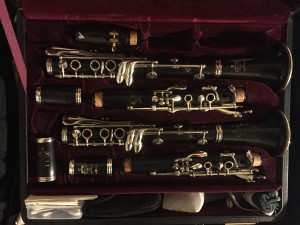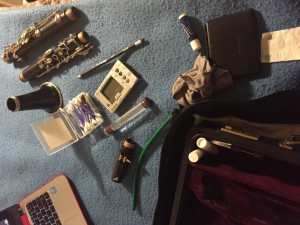Spring Cleaning: Clarinet Edition
It’s that time of year again, when you trade in your peppermint mochas for iced coffee, bid adieu to your winter jacket, shamelessly post pictures of blooming flowers on social media…..and reluctantly realize you should really start your spring cleaning.
If the idea of spring cleaning is foreign to you, I’m here to help. I’m a lifelong professional neat-freak and organizer. I don’t let seasons dictate my cleaning habits, although there’s something satisfying about marking the end of winter with a clean space. I am a firm believer in the power of an organized room. If you are surrounded by visual clutter, it is transferred into mental clutter (aka stress!).
If you begin every practice session by opening a messy case, frantically searching for your dried-up tube of cork grease or music you can never seem to locate, how can you expect to have a productive practice session? Before you have even played a note, your mind is subconsciously transforming your physical clutter into mental clutter. This doesn’t bode well at all for successful practicing.
Let’s start with the basics: Your clarinet. When was the last time you had your clarinet adjusted or repaired? That sticky key that’s been bothering you? One-and-one B-flat not quite covering? Pinky key tensions don’t match? Now’s the time to make a list of all your clarinet’s ailments (or have a teacher help you) and take your instrument to a reputable shop to be repaired. Think of this like a physical for your clarinet – even if nothing is visibly wrong, it might need new pads, corks, or something invisible to an untrained professional.
Next step: Your case and case cover. Take everything out of both your case and any case protector/cover. Yes, everything. Really. Toss anything old, expired, or broken (cork grease, used teeth cushions, etc). Replace anything you threw out and purchase items you need to restock. (This is the perfect opportunity to replace the swab you’ve been using since 2009.)
After you’ve reevaluated and replenished your stock, now it’s time to clean the case and the cover. If possible, wash the case covers or protectors. Before doing this, check the labels or product website to make sure you’re not going to ruin the fabric by washing it. If it’s frayed, ripped, damaged, or past the point of no return, it’s time to buy another case or cover. To clean the inside lining of the case, you can use a lint-roller, tape, or mini vacuum to clean velvet or fleece lining.
After you place everything back neatly in your case, sharpen your pencils (or replace the lead if you use mechanical pencils), and get ready to enjoy your newly organized case and productive practice sessions!


One Comment
Albert Nemiroff
A scale you might add to scale practice is Ahava Rabba. It is used in Jewish prayer, klezmer and popular song, e.g., Hava Nagilah, The scale is doh ra ri mi fa sol le te doh, yes, nine steps. That make writing a key signature challenging. The liturgical piece I was called to play on Bb clarinet looked to me as though it was in concert C minor, but the printed key signature was F minor. It is related to the Phrigian church mode.
Thank you for all of the teaching vignettes you contributed here.
Best,
Albert